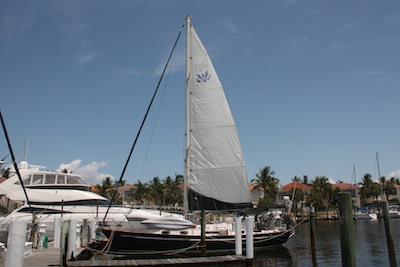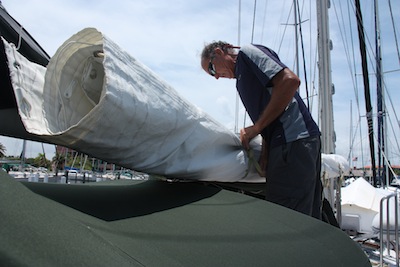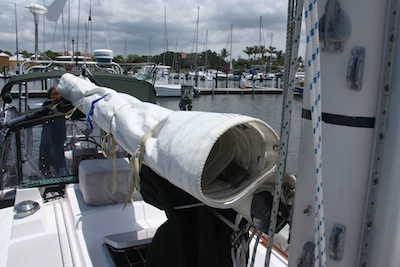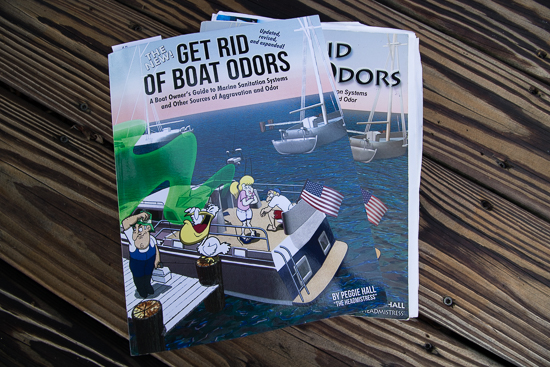Commuter cruisers can extend the life of expensive cruising sails by storing them properly while they’re not in use. Because the mainsail is used for so many things … from steadying the boat while motorsailing to surfing the boat down waves in big wind with two or three reef points, it takes a lot of abuse. Add in the salt water environment and it gets worse. The good news is it only takes a little extra attention to maintain the sails!
1. Always take the sails off the boat if you’ll be gone for an extended period of time – we’ve been in marinas that require all the sails and canvas be off the boat even if we’re only gone a month, but it’s during hurricane season. It may be a hassle, but it also might save your boat if a hurricane decides to pay an unexpected visit!
2. In our getting ready to leave the boat process, we pick a nice calm day and hoist the sails, rinsing them with a pressurized hose nozzle as they go up so the entire sail gets a fresh water rinse. Then we leave the sail hoisted long enough for it to completely dry. If you store a damp sail, you’ll be sure to have mildew when you return. Avoid that complication by making sure the sail is dry! In Shelter Bay Marina, by the Panama Canal Jetty, Colon Panama, we were able to totally remove the sail and take it up to the large concrete area to wash and dry it – it was much easier to clean, but not so easy to make sure it was totally dry because the underside developed condensation. If you choose to take the sail off the boat for this step, make sure it’s totally dry before you roll it!
3. Dropping the main, we unattach the halyard and then move the lazy jacklines forward to the mast and out of the way. For this step we don’t care that it’s not flaked properly because we’re going to roll it. Because we can never believe weather predictions, we choose a nice calm day several days before we’re actually ready to leave the boat – and then roll the main, secure it with sail ties but leave it on the boom protected by the sail cover.
4. If you have full battens in the mainsail like us, be sure to roll straight – you don’t want a batten bent in the rolling process. Then we use sail ties to secure the rolled mainsail — the sail ties are inserted between the boom and main so that they’re only securing the main. We want to be able to easily slide the main off the boom when it comes time to move it below to store for the summer. One caveat — watch the weather – we do not want the sail to get wet again before we move it down below. So if it’s going to rain, we’ll remove and store it earlier than planned. It’s a pain to step over for a few days, but it’s much less of a pain to walk around the sail than it is to try to clean all the mildew off caused by storing a damp sail!
5. Once the sail is secure, we cover it with the sail cover until literally our last day aboard – if we remove it now with several days left before we leave the boat, it will just be in the way stretching the length of the salon walkway below.
Oh wait! Dolphins playing just behind the boat, take a break for a few minutes and watch the dolphins! 🙂
6. Finish getting the sail ties in place and replace the sail cover.
7. The very last step is to remove the sail from the boom and get it down below. For us this involves sliding it forward until it clears the boom track, unzipping and raising the dodger front window and sliding the sail through until one end is out the back of the cockpit and the other end is positioned to be lowered down the companionway.
Now that the main sail is safely stored below we can finish all our last minute preparations to l leave the boat for hurricane season.
Do you have a special way to prepare the mainsail for storage during the time you’ll be gone from the boat? Please leave a comment and share! Cheers! Jan


















Thanks for sharing valuable tips on how to extend the life of main sail.